Part of what makes Mexican mercados beautiful is the knowledge that they began very long ago.
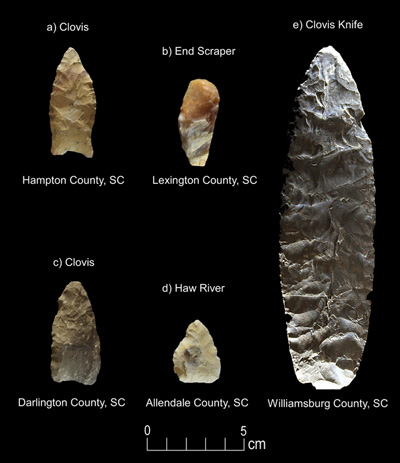
Assortment of Clovis points; copyright free image courtesy of Christopher Moore and other authors of the 2023 study "Paleoamerican exploitation of extinct megafauna revealed through immunological blood residue and microwear analysis, North and South Carolina, USA," made available through Wikimedia Commons.
For, long before Europeans set foot into the New World, mercados were being conducted in the area now known as Mexico. This is not to say that the first humans to populate future Mexican territory carried with them the mercado concept. These people probably arrived in North America and Mexico at the end of the last Ice Age, about 13,500 years ago. They lived lives that were far too unstructured to sustain mercados. Those first Americans, known to science as the Clovis Culture, were big-game hunters wandering the landscape in small groups. Indications of Clovis presence so far have been found in Baja California, Chihuahua, Durango, Sonora, Sinaloa, Jalisco, Hidalgo and Oaxaca. Clovis people may have managed occasional exchanges of articles between families or clans, but there wasn't much more "business" than that.
When the last Ice Age glaciers retreated from North America, climate south of the glaciers, including today's Mexican territory, changed drastically. Predominantly cool and wet conditions were replaced by mostly hot and dry weather patterns. The Clovis Culture's big game, such as woolly mammoths and giant elk, disappeared. So, too, about 11,000 years ago, did the Clovis Culture which had been based on hunting the big animals.
Then for thousands of years the Clovis people's paleolithic descendants ate nuts and berries, grubbed for roots, and caught small animals. Finally, around 2000 BC, at least some of Mexico's root grubbers and rabbit clubbers discovered the advantages of tilling the soil and planting crops.

Human cranium dated around 7000 years ago found in Coxcatlán Cave, Puebla state; copyright free image courtesy of "Yavidaxiu" made available through Wikimedia Commons.
Their main crops were corn, beans, and squash. The oldest ears of corn, or maize, known by humans -- just tiny nubbins that today any self-respecting farmer would throw away -- have been excavated in Coxcatlán Cave, about twenty-five miles southeast of Tehuacán, in southeastern Puebla State.
Agriculture requires people to stay in once place for long periods of time, to take care of the crops. In return, agriculture provides harvests that can be stored through good weather and bad. Farming populations are thus much less dependent on weather and their luck in finding natural food sources throughout the year.
History has shown that once a people acquires a stable food supply and becomes sedentary, a chain reaction is initiated. The population's numbers increase and social patterns grow more complex. Among the common people, upper and lower classes come into existence. Both upper and lower classes need food and other basics for living. The upper classes also wish to impress others with their superiority by possessing things regular people can't have. Thus the production of all kinds of things, for both upper and lower classes, becomes the foundation for commerce and industry.
When given a choice, some people gravitate toward activities such as growing corn, while others find greater satisfaction in making items with their hands, such as baskets or tools. Naturally, in any community inhabited by both corn growers and basket and tool makers, eventually it occurs to everyone that the food growers can trade their surplus food for baskets and tools, and the basket and tool makers can trade their baskets and tools for food.
Thus the mercado is born.
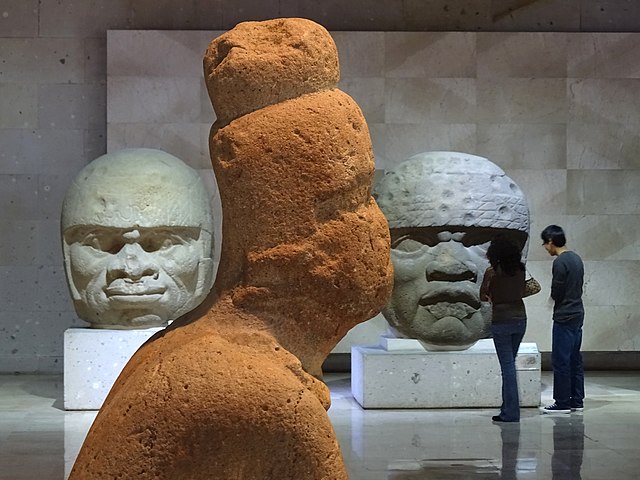
Olmec figures with visitors at the Museum of Anthropology in Xalapa, Veracruz; copyright free image courtesy of Adam Jones made available through Wikimedia Commons.
Around 3500 years ago there came into being the first major culture of both Mexico and the entire New World, the Olmec Culture. By 3200 years ago, along Mexico's Gulf Coast, the Olmecs had erected impressive temple cities and huge stone sculptures. They also possessed a rudimentary calendar and a writing system, which may have helped them fix dates for periodic mercados, and keep track of their inventories.
Though the Olmecs' temple cities were used mainly for religious purposes, not for trading, it is easy to visualize at least rudimentary mercado activities taking place just outside ecclesiastical precincts. Around many of Mexico's ancient temples, archaeologists find traces of regular dwelling places. Whenever large numbers of people come together, something like a mercado is bound to materialize, simply because it is the most natural way of exchanging things that people need.
Between 3000 and 2500 years ago, as the Olmec culture continued to flourish on Mexico's Gulf Coast, other parts of Mexico, especially in the south-central and southern regions, as well as on the Pacific Coast of Guatemala and El Salvador, a mosaic of chiefdoms developed. Archaeological remains show that the members of these chiefdoms kept in contact with one another and traded with one another. Traded goods included jade, marine shells, obsidian, magnetite, and pottery. Among the chiefdoms' high-ranking families, ritual exchanges of rare and exquisitely crafted gifts also took place.

Articulated jade pendant representing snake excavated at Maya ruins of Calakmul in Campeche state, dated from 1800-1400 years ago; copyright free image courtesy of Bernard DUPONT made available through Wikimedia Commons.
Then, as now, Mexico's rambunctious physiography was reflected in mercado offerings. Papaya grew in the lowlands, cactus tunas in the highlands; jaguar skins were available from lowland jungles, resplendent quetzal feathers from highland cloud-forests. Mexico's tropical lowland forests were particularly bountiful. There archeologist Barbara Voorhies has documented more than 150 species of plant, and twenty-five kinds of animal, capable of yielding durable and transportable products such as food items, fuel, dyes, fibers, incense, medicinal herbs, and pelts.
By 400 BC, much of Mexico's Yucatán Peninsula, and the lowlands of the southern state of Chiapas, were populated by early communities of Maya farmers. These agricultural people appear to have lived in communities of several hundred. Pollen and other vegetative remains indicate that, beside their main cultivated crops of corn, beans, and squash, they ate -- and surely traded -- commodities such as amaranth, avocado, breadnut, cassava, chili, guava, mombin, nance, papaya, pineapple, sapodilla, soursop, sweet potato, and yucca.
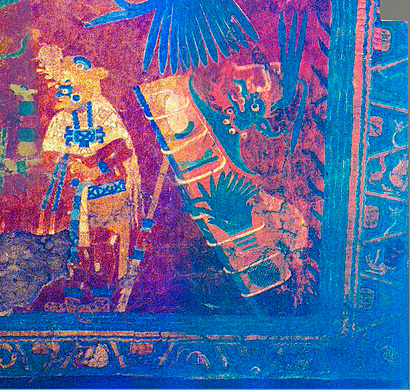
Detail of image of mural at Cacaxtla Ruins, Tlaxcala state; copyright free image courtesy of "HJPD" made available through Wikimedia Commons.
Time passed, villages in much of Mexico grew into towns and cities, and mercados kept pace by growing in size and complexity. Between Mexico City and Puebla, at the ruin known as Cacaxtla, a temple mural dating from about 1300 years ago, seen at the right, portrays God "L," the patron of long-distance traders. He stands beside his pack bearing now-discolored green Quetzal feathers and a turtle shell, both items from the tropical lowlands and not available at high-elevation Cacaxtla. Cacaxtla's success as a trading center was owed to the fact that it straddled the main trade route between the dominant empire at the time, Teotihuacan (just northwest of modern Mexico City), and the resource-rich Gulf Coast.
In places, such as the Maya lowlands of southern Mexico, population densities at this time reached as high as 2,600 persons per square mile in urban centers, and between 500 to 1,300 per square mile in certain rural areas. As civilization evolved, an ever greater percentage of the population became non-agricultural. The numbers of royal families and servants, warriors, entrepreneurs, and artisans multiplied. Certainly these nonfarming folk depended on mercados like never before.
The overwhelming desire of ancient Mexicans to possess exotic merchandise is attested to by Maya ruins on Isla Cerritos, an island only 650 feet in diameter, off the north coast of the Yucatán Peninsula, due north of the famous Maya ruin of Chichén Itzá. Isla Cerritos was Chichén Itzá's main seaport during that city's apogee of power from 900 AD to 1200. Here archaeologists have mapped a huge seawall and extensive docks, and found traces of an abundance of trade goods such as turquoise, obsidian, and ceramics. These goods came from places as far away as central Mexico and Central America.
During this time, the Maya -- especially the Chontal Maya living among the maze of streams in the swampy area at the mouths of the huge Usumacinta and Grijalva Rivers -- transported merchandise in spacious dugout canoes capable of traveling long distances, and holding forty or more passengers. In the summer of 1502, Columbus, on his fourth voyage of discovery to the Americas, encountered a large merchant canoe off Honduras's northern coast.
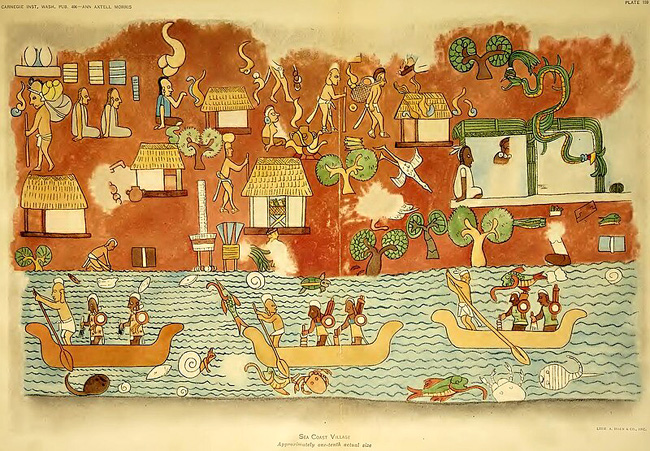
Illustration of mural in the Temple of the Warriors at Chichén Itzá in Yucatán; it shows a Mayan coastal town as illustrated in a 1931 publication of the Carnegie Institute, by Ann Axtel Morris; public domain image courtesy of Ann Axtel Morris made available through Wikimedia Commons.
Maya specialist Eric Thompson supposes that this canoe was probably of Chontal-Maya registry, traveling from Mexico's Tabasco State to the northern coast of Honduras and Guatemala. Further he guesses that the copper material came from mainland Mexico. The textiles, a specialty of Yucatán known to have been shipped to Honduras, had probably been obtained in trade en route and would be exchanged for more cacao at Honduras's Nito trading station. The cacao had probably been acquired along the Belizean coast, and would be disposed of in Yucatán on the return route.
Commerce was no less vigorous at this time in the Mexican interior. It is known that during these years even indigenous nations warring with one another often continued to exchange merchandise; trade missions to distant Indian capitals were notorious as opportunities for spying on the enemy.
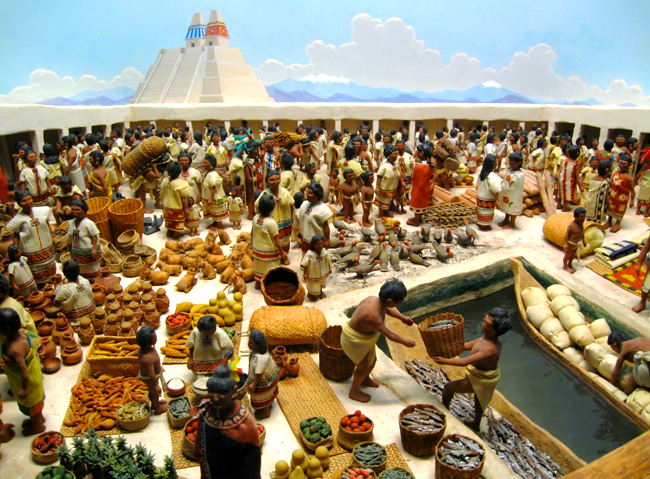
Tlatelolco marketplace, the largest of the Aztec's markets, during the early 1530s, as depicted at Chicago's Field Museum of Natural History; copyright free CC-BY-SA 3.0 image courtesy of Joe Ravi made available through Wikimedia Commons.
Goods found in Mexican mercados at the time of the Spaniards' arrival were not always acquired by what we would regard as standard marketing procedure. Once a chiefdom was vanquished in war, it had to pay tribute to its conqueror, and this tribute often showed up as merchandise in the victor's mercados.
At the time of the Spanish conquest, the two main Indian empires in the Mexican uplands were those of the Aztec, in the area of modern Mexico City, and the Tarascan, centered around today's state of Michoacán. By the early 1500's, the highland Tarascans had conquered considerable territory along the hot Pacific coast. Among the goods the vanquished coastal groups had to pay in tribute to the Tarascans were gold, copper, cinnabar, honey and wax, cacao, resins, salt, cotton, painted gourds, and dried fruit. The Tarascans also dominated territory in the eastern highlands, from which came tribute in the form of cotton clothing, corn, chili pepper, wood, and hunted game. Villages on the shores of Lake Pátzcuaro were obliged to contribute fish, aquatic birds, and reed matting. The Maya empire had collapsed during and around the 800s.